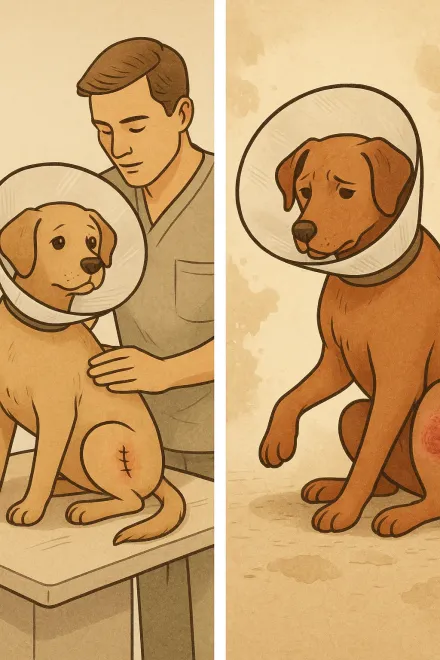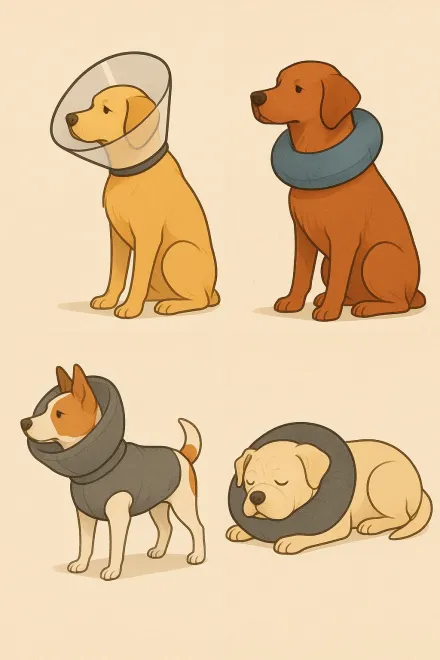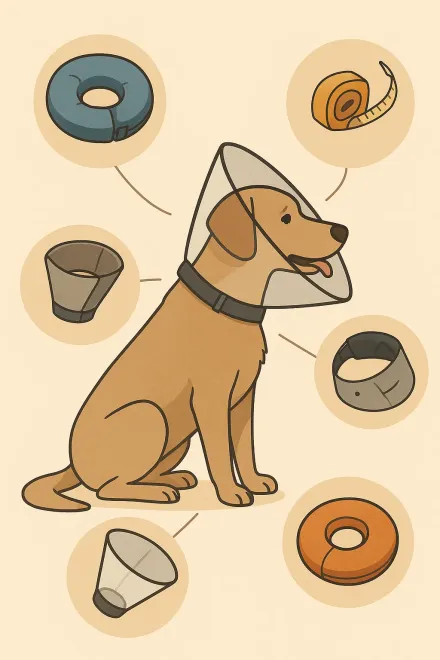Cone Collars for Dogs
Cone collars, also known as recovery or cone collars, are devices designed to prevent dogs from licking, biting, or scratching sensitive areas of their bodies. They are essential after surgery, dermatological treatments, or skin injuries to ensure a safe and complication-free recovery.
This guide explains the types of Cone collars available, when they are necessary, what to consider when choosing one, and which brands offer the most comfortable and effective models.
View Cone collars for Dogs on Amazon
What Is an Cone Collar For and When to Use It?
The Cone collar plays a key role in post-surgery recovery or wound treatment. It prevents dogs from accessing the affected area with their mouth or paws, helping avoid infections, broken stitches, irritation, or worsening of skin conditions.
- After surgery: Prevents dogs from licking or chewing stitches.
- During dermatological treatments: Stops them from scratching or biting itchy, inflamed, or allergic areas.
- For external wounds or injuries: Aids healing by preventing the dog from interfering with the natural recovery process.
Using an Cone collar correctly can mean the difference between a smooth recovery and costly complications.
Types of Cone Collars and Their Differences
There are several types of Cone collars, each with advantages depending on the procedure, affected area, or dog’s temperament:
- Rigid collars (clear plastic): The most common. Offer maximum protection but can be uncomfortable in tight spaces.
- Inflatable collars: Pillow-like inflatable rings around the neck. More comfortable, but not suitable for all body areas.
- Soft or fabric collars: Made of padded materials. Flexible, lightweight, and less invasive, but easier for dogs to manipulate.
- Donut-shaped collars: A variation of inflatable collars with a round design. Allow for easier movement and more comfortable sleep.
Choosing the right one depends on your dog’s size, behavior, injury location, and treatment duration.


Tips for Choosing the Best Cone Collar
To ensure the collar works properly and doesn’t cause unnecessary stress, consider the following:
- Correct size: It should stop the dog from reaching the wound but still allow normal eating, drinking, and movement.
- Comfort: Choose padded models or ones with soft edges, especially for long treatments.
- Secure fit: The collar should be snug enough to stay in place but not tight enough to choke or easily fall off.
- Material: If your dog is sensitive or nervous, avoid rigid models and try soft or inflatable versions instead.
- Expected duration: For short-term use, prioritize effectiveness. For longer recovery periods, aim for comfort and protection.
Always consult your vet to determine the most suitable type of Cone collar for your specific case.
Frequently Asked Questions About Cone Collars for Dogs
How long should my dog wear the Cone collar?
It depends on the reason. In general, your dog should wear it until wounds are fully healed or your vet says otherwise. For minor surgeries, 7–10 days is typical, but it may take longer in other cases.
Can my dog sleep with the collar on?
Yes. These collars are designed for 24/7 wear. If your dog has trouble resting, try softer or inflatable models.
Is an inflatable collar better than a rigid one?
It depends on the wound location. Inflatable collars are more comfortable but less effective for wounds on front legs or the lower body. Rigid collars offer better overall protection.
Can I remove the collar at home?
Only if you can supervise your dog at all times and are sure they won’t lick or bite the wound. Otherwise, it’s best to keep it on.
How do I know if the collar fits correctly?
It should be snug but not tight. You should be able to fit one or two fingers between the collar and your dog’s neck. It must prevent your dog from reaching the affected area with their mouth or paws.
Are there sizes for small breeds or puppies?
Yes. Most manufacturers offer sizes from XS to XL, adapted to each dog’s size and weight. For puppies, look for lightweight and soft models that won’t cause stress.
Can I use clothing instead of an Cone collar?
In some cases, yes—if the wound is on the body. But for wounds on the face, legs, or rear, the collar is much more effective at preventing access.
